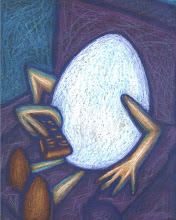Audrey Flack
Audrey Flack,
Study for Marilyn (Vanitas) II, 1977
Audrey Flack
This artist is another one of my living heroes. I think it's quite an accomplishment when a visual artist makes history while they are still alive. Audrey made a name for herself at a very young age and still teaches art today in New York.I pulled this image from a site that placed her work under photography. This is not a photograph but shows how photo-realistic her work could actually be. If you were to view one of Flack's paintings in person, it would be obvious that it is not a photograph because of its size and accuracy. Most cameras cannot reproduce quality images the size of a wall without loosing clarity. Her painting technique at this time was airbrush over oil.
One of my favorite quotes from the well-known textbook author and historian, Henry Sayre states, "Sometimes the greatest challenge in art, is art itself." He was referencing Audrey's work when he made this statement and I believe it is a beautiful argument for all photo realists. Their work is so skillfully done that it is hard to tell if it's a photo or a painting. Many of the airbrush artists brought photo realism to its peak in the 80s and 90s.
I remember one of my professors scoffing at the photo realists movement and said, "It's like they are so seduced by their skill that their paintings have no soul." As much as I loved this teacher, I was appalled by his commentary. Very few people could look at this image and say it has no soul. Ironically enough, Audrey wrote a book called "Art and Soul" which I cherish and have read many times when I'm discouraged by my own art struggles.
Audrey Flack is using iconography to describe the content behind this piece. She did more than one painting on the subject of Marylin Monroe and the still life was her primary means of communication at this time in her art career. Study the objects closely and think of the symbolic meaning each one has. Her work is fascinating and each object's story, when combined with other objects tells about the complex life of this tortured soul we called, Marylin Monroe.
Although I've never read that Audrey Flack was a feminist, she does tackle many of the issues women face today. She began sculpting goddesses later in her art career and was equally skillful at the realism in her 3-D works. She has left quite a long legacy to the art world and is still contributing to its ever-evolving nature to this day.












